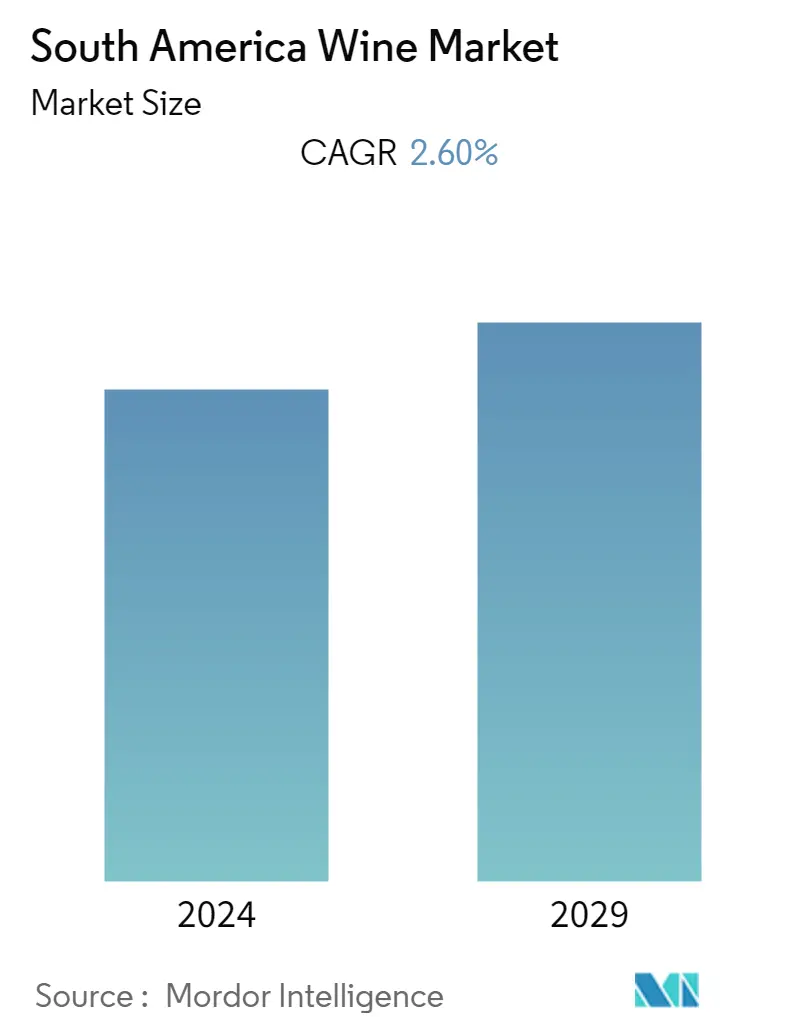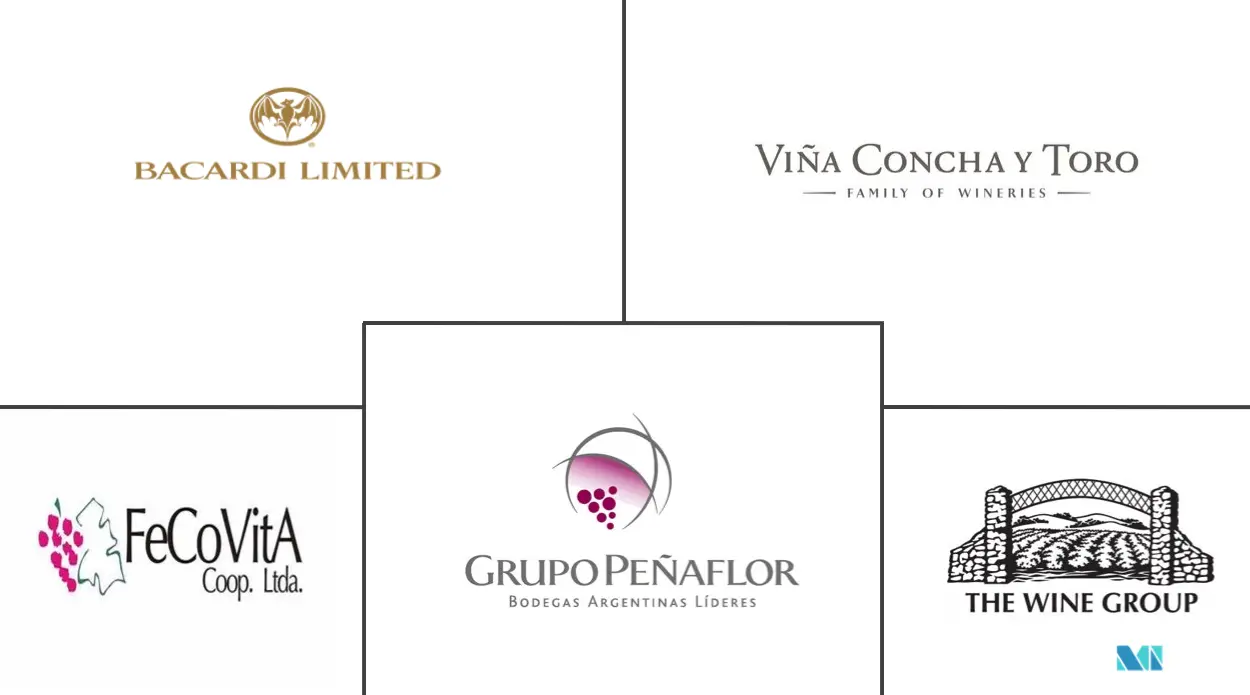Market Size of South America Wine Industry

| Study Period | 2019 - 2029 |
| Base Year For Estimation | 2023 |
| Forecast Data Period | 2024 - 2029 |
| Historical Data Period | 2019 - 2022 |
| CAGR | 2.60 % |
| Market Concentration | Medium |
Major Players
*Disclaimer: Major Players sorted in no particular order |
South America Wine Market Analysis
The South America Wine market is projected to register a CAGR of 2.6% during the forecast period, 2022-2027.
The demand for wine in South America is anticipated to rise as a result of its health benefits, premiumization of wine goods, innovation in flavor, and more sophisticated distribution networks. The desire for fresh and unusual flavors like Riesling wine and other tropical fruit wines is predicted to increase, along with customer tastes and preferences changing.
The South American wine industry is booming, and this is due to the region's special advantages. In terms of wine output, Chile is ninth in the world, only in front of Portugal, and Argentina is fifth. The use of more sophisticated production technologies was made possible by increased global trade and investment openness, which supported the alignment of countries like Chile and Argentina's wine industry with international standards.
Vineyards are protected from pests and diseases by the region's high altitude and low humidity. Due to this, Argentina's production costs are lower than those of other nations. Malbec, bonarda, and cabernet sauvignon are the primary red wine varieties produced in Argentina, whereas torrontes and chardonnay are the primary white wine varieties. Argentina's wine is more accessible, which is driving up import demand. For instance, in January 2022, Miami-based importer Origins Organic launched a new canned Argentine wine brand Le Petit Verre. The Malbec and Bubbly Rosé are Le Petit Verre's first offerings.
South America Wine Industry Segmentation
Wine is an alcoholic drink typically made from fermented grape juice. The South America Wine market is segmented by product type, color, distribution channel, and geography. Based on product type market is segmented into still wine, sparkling wine, fortified wine, and vermouth. Based on the color market is segmented into red wine, rose wine, and white wine, By distribution channel, the market is divided into on-trade and off-trade. Off-trade is further segmented into supermarkets/hypermarkets, specialty stores, online retailers, and other distribution channels. Based on geography market is segmented into Brazil, Argentina, and Rest of South America. For each segment, the market sizing and forecast have been done based on value (in USD million).
| By Type | |
| Still Wine | |
| Sparkling Wine | |
| Fortified Wine | |
| Vermouth |
| By Color | |
| Red Wine | |
| Rose Wine | |
| White Wine |
| By Distriburtion Channel | ||||||
| On-Trade | ||||||
|
| By Geography | |
| Argentina | |
| Brazil | |
| Rest of South America |
South America Wine Market Size Summary
The South American wine market is experiencing a notable expansion, driven by factors such as the health benefits of wine, the premiumization of wine products, and innovations in flavor and distribution. The region's unique advantages, including high altitude and low humidity, protect vineyards from pests and diseases, contributing to lower production costs, particularly in Argentina. This has allowed countries like Argentina and Chile to align their wine industries with international standards, enhancing their global trade presence. The market is characterized by a growing demand for fresh and unusual flavors, with consumer preferences shifting towards more sophisticated wine options. The increasing number of independently owned vineyards, which emphasize novel flavors and brewing techniques, is further propelling market growth across South America's diverse wine-producing regions.
Argentina stands out as a leading wine producer in South America, with Mendoza being its most renowned wine region. The country's wine tourism, which includes vineyard tours and wine tastings, attracts both local and international visitors. The rising disposable income among the young population and the trend of visiting pubs and bars are boosting consumer interest in spirits, while the shift towards at-home consumption has increased the demand for high-quality wine. The competitive landscape of the South American wine market is marked by the presence of global and domestic companies such as The Wine Group, Vina Concha Y Toro, and Bacardi Limited, which hold significant market shares due to their diverse wine offerings. These companies are expanding their geographic reach and engaging in strategic mergers and acquisitions to strengthen their market positions.
South America Wine Market Size - Table of Contents
-
1. MARKET DYNAMICS
-
1.1 Market Drivers
-
1.2 Market Restraints
-
1.3 Porter's Five Force Analysis
-
1.3.1 Threat of New Entrants
-
1.3.2 Bargaining Power of Buyers/Consumers
-
1.3.3 Bargaining Power of Suppliers
-
1.3.4 Threat of Substitute Products
-
1.3.5 Intensity of Competitive Rivalry
-
-
-
2. MARKET SEGMENTATION
-
2.1 By Type
-
2.1.1 Still Wine
-
2.1.2 Sparkling Wine
-
2.1.3 Fortified Wine
-
2.1.4 Vermouth
-
-
2.2 By Color
-
2.2.1 Red Wine
-
2.2.2 Rose Wine
-
2.2.3 White Wine
-
-
2.3 By Distriburtion Channel
-
2.3.1 On-Trade
-
2.3.2 Off-Trade
-
2.3.2.1 Supermarkets/Hypermarkets
-
2.3.2.2 Specialty Stores
-
2.3.2.3 Online Retailers
-
2.3.2.4 Other Distribution Channels
-
-
-
2.4 By Geography
-
2.4.1 Argentina
-
2.4.2 Brazil
-
2.4.3 Rest of South America
-
-
South America Wine Market Size FAQs
What is the current South America Wine Market size?
The South America Wine Market is projected to register a CAGR of 2.60% during the forecast period (2024-2029)
Who are the key players in South America Wine Market?
The Wine Group, Vina Concha Y Toro, Fecovita Co-op., Grupo Penaflor and Bacardi Limited are the major companies operating in the South America Wine Market.

